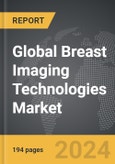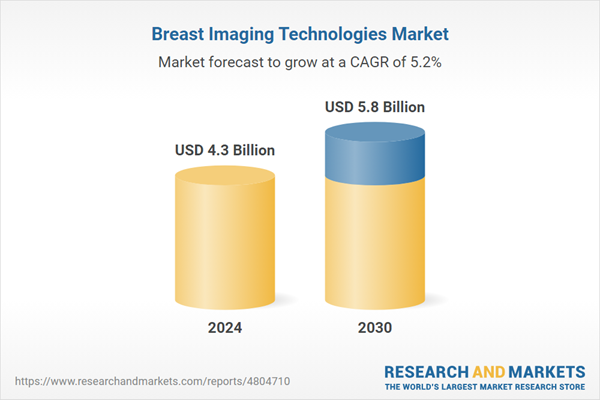The global market for Breast Imaging Technologies was valued at US$4.3 Billion in 2024 and is projected to reach US$5.8 Billion by 2030, growing at a CAGR of 5.2% from 2024 to 2030. This comprehensive report provides an in-depth analysis of market trends, drivers, and forecasts, helping you make informed business decisions. The report includes the most recent global tariff developments and how they impact the Breast Imaging Technologies market.
Segments: Type (Ionizing Technologies, Non-Ionizing Technologies); End-Use (Hospitals & Clinics, Diagnostic Imaging Centers, Breast Care Centers, Other End-Users).
Geographic Regions/Countries: World; United States; Canada; Japan; China; Europe (France; Germany; Italy; United Kingdom; Spain; Russia; and Rest of Europe); Asia-Pacific (Australia; India; South Korea; and Rest of Asia-Pacific); Latin America (Argentina; Brazil; Mexico; and Rest of Latin America); Middle East (Iran; Israel; Saudi Arabia; United Arab Emirates; and Rest of Middle East); and Africa.
The analysts continuously track trade developments worldwide, drawing insights from leading global economists and over 200 industry and policy institutions, including think tanks, trade organizations, and national economic advisory bodies. This intelligence is integrated into forecasting models to provide timely, data-driven analysis of emerging risks and opportunities.
Global Breast Imaging Technologies Market - Key Trends and Drivers Summarized
Why Are Breast Imaging Technologies at the Forefront of Cancer Detection?
Breast imaging technologies have become crucial in the early detection and diagnosis of breast cancer, a disease that affects millions of women worldwide. But why are these technologies so vital? Early detection remains the most effective strategy in reducing breast cancer mortality rates, and advanced imaging techniques offer a non-invasive means to identify tumors before they become palpable or symptomatic. Mammography has long been the gold standard in breast cancer screening, utilizing low-dose X-rays to detect abnormalities. However, in recent years, newer technologies such as digital breast tomosynthesis (DBT), magnetic resonance imaging (MRI), and ultrasound have enhanced diagnostic accuracy, especially in women with dense breast tissue where traditional mammograms may be less effective. These innovations not only provide more detailed images but also help reduce false positives and negatives, minimizing unnecessary biopsies and ensuring timely interventions. As awareness of breast health grows, and screening programs expand globally, breast imaging technologies are becoming even more integral to preventive healthcare.What Technological Advancements Are Transforming Breast Imaging Today?
Recent innovations have revolutionized breast imaging technologies, leading to better diagnostic capabilities and patient outcomes. One of the most notable advancements is digital breast tomosynthesis (DBT), often referred to as 3D mammography, which provides multiple layered images of the breast, offering a more comprehensive view than traditional 2D mammograms. This technique has been shown to improve cancer detection rates, particularly in women with dense breast tissue, where overlapping tissue structures might obscure tumors in 2D images. Another critical development is the increasing use of contrast-enhanced mammography and breast MRI, which can detect cancers that are invisible on regular mammograms by highlighting areas of abnormal blood flow associated with tumor growth. Additionally, automated breast ultrasound (ABUS) is gaining traction as an important tool for screening women with dense breasts, offering a complementary imaging modality that improves detection rates. Artificial intelligence (AI) is also making strides in breast imaging by assisting radiologists in reading images, identifying subtle signs of malignancy, and reducing diagnostic errors.How Are Changing Guidelines and Patient Expectations Influencing Breast Imaging?
The evolving landscape of breast imaging is shaped not only by technological innovation but also by updated medical guidelines and shifting patient expectations. Health organizations worldwide, including the American Cancer Society and the U.S. Preventive Services Task Force, regularly update their screening recommendations based on emerging evidence. For example, guidelines increasingly emphasize personalized screening protocols, considering factors such as age, genetic predisposition, and breast density. This has led to a greater reliance on supplemental imaging techniques like MRI or ultrasound, particularly for women at high risk of breast cancer or those with dense breast tissue. Patients themselves are becoming more proactive in their healthcare decisions, seeking earlier and more frequent screenings, especially as awareness of breast health rises. Additionally, many patients now expect a higher degree of comfort and less radiation exposure, driving demand for non-invasive, low-dose imaging technologies. Moreover, the rise of telemedicine and digital health solutions is encouraging the development of remote diagnostic tools, allowing patients in underserved or rural areas to access high-quality breast imaging services without traveling to specialized centers. As patient advocacy and regulatory bodies push for more individualized care, breast imaging technologies are increasingly aligning with these demands, promoting both better outcomes and greater patient satisfaction.What Are the Key Drivers of Growth in the Breast Imaging Technologies Market?
The growth in the breast imaging technologies market is driven by several factors, reflecting advancements in technology, evolving healthcare policies, and changing patient needs. First, technological innovations such as digital breast tomosynthesis, AI-assisted imaging, and contrast-enhanced techniques are improving the accuracy of cancer detection, making them attractive to both healthcare providers and patients seeking more reliable diagnostic tools. Second, the increasing prevalence of breast cancer worldwide is amplifying the need for regular screenings and early diagnosis, fueling demand for state-of-the-art imaging systems. Third, regulatory frameworks emphasizing early detection and preventive healthcare are pushing governments and healthcare institutions to invest in advanced imaging technologies as part of broader public health initiatives. Fourth, the rising awareness of breast cancer, particularly in developing regions, is encouraging the adoption of breast imaging technologies in countries where access to such tools has historically been limited. Finally, the growing trend toward personalized medicine and patient-specific care, coupled with advancements in genetic screening, is driving more targeted and tailored imaging approaches, leading to increased demand for a variety of breast imaging modalities.Report Scope
The report analyzes the Breast Imaging Technologies market, presented in terms of units. The analysis covers the key segments and geographic regions outlined below.Segments: Type (Ionizing Technologies, Non-Ionizing Technologies); End-Use (Hospitals & Clinics, Diagnostic Imaging Centers, Breast Care Centers, Other End-Users).
Geographic Regions/Countries: World; United States; Canada; Japan; China; Europe (France; Germany; Italy; United Kingdom; Spain; Russia; and Rest of Europe); Asia-Pacific (Australia; India; South Korea; and Rest of Asia-Pacific); Latin America (Argentina; Brazil; Mexico; and Rest of Latin America); Middle East (Iran; Israel; Saudi Arabia; United Arab Emirates; and Rest of Middle East); and Africa.
Key Insights:
- Market Growth: Understand the significant growth trajectory of the Ionizing Technologies segment, which is expected to reach US$3.3 Billion by 2030 with a CAGR of a 4.7%. The Non-ionizing Technologies segment is also set to grow at 5.8% CAGR over the analysis period.
- Regional Analysis: Gain insights into the U.S. market, valued at $1.1 Billion in 2024, and China, forecasted to grow at an impressive 8.5% CAGR to reach $1.2 Billion by 2030. Discover growth trends in other key regions, including Japan, Canada, Germany, and the Asia-Pacific.
Why You Should Buy This Report:
- Detailed Market Analysis: Access a thorough analysis of the Global Breast Imaging Technologies Market, covering all major geographic regions and market segments.
- Competitive Insights: Get an overview of the competitive landscape, including the market presence of major players across different geographies.
- Future Trends and Drivers: Understand the key trends and drivers shaping the future of the Global Breast Imaging Technologies Market.
- Actionable Insights: Benefit from actionable insights that can help you identify new revenue opportunities and make strategic business decisions.
Key Questions Answered:
- How is the Global Breast Imaging Technologies Market expected to evolve by 2030?
- What are the main drivers and restraints affecting the market?
- Which market segments will grow the most over the forecast period?
- How will market shares for different regions and segments change by 2030?
- Who are the leading players in the market, and what are their prospects?
Report Features:
- Comprehensive Market Data: Independent analysis of annual sales and market forecasts in US$ Million from 2024 to 2030.
- In-Depth Regional Analysis: Detailed insights into key markets, including the U.S., China, Japan, Canada, Europe, Asia-Pacific, Latin America, Middle East, and Africa.
- Company Profiles: Coverage of players such as Aurora Imaging Technology, Inc., Dilon Technologies, Inc., FUJIFILM Holdings Corporation, GE Healthcare, Hologic, Inc. and more.
- Complimentary Updates: Receive free report updates for one year to keep you informed of the latest market developments.
Some of the 42 companies featured in this Breast Imaging Technologies market report include:
- Aurora Imaging Technology, Inc.
- Dilon Technologies, Inc.
- FUJIFILM Holdings Corporation
- GE Healthcare
- Hologic, Inc.
- Philips Healthcare
- Siemens Healthineers
- SonoCine, Inc.
- Toshiba Corporation
Tariff Impact Analysis: Key Insights for 2025
Global tariff negotiations across 180+ countries are reshaping supply chains, costs, and competitiveness. This report reflects the latest developments as of April 2025 and incorporates forward-looking insights into the market outlook.The analysts continuously track trade developments worldwide, drawing insights from leading global economists and over 200 industry and policy institutions, including think tanks, trade organizations, and national economic advisory bodies. This intelligence is integrated into forecasting models to provide timely, data-driven analysis of emerging risks and opportunities.
What’s Included in This Edition:
- Tariff-adjusted market forecasts by region and segment
- Analysis of cost and supply chain implications by sourcing and trade exposure
- Strategic insights into geographic shifts
Buyers receive a free July 2025 update with:
- Finalized tariff impacts and new trade agreement effects
- Updated projections reflecting global sourcing and cost shifts
- Expanded country-specific coverage across the industry
Table of Contents
I. METHODOLOGYII. EXECUTIVE SUMMARY2. FOCUS ON SELECT PLAYERSIII. MARKET ANALYSISSOUTH KOREAREST OF ASIA-PACIFICARGENTINABRAZILMEXICOREST OF LATIN AMERICAIRANISRAELSAUDI ARABIAUNITED ARAB EMIRATESREST OF MIDDLE EASTIV. COMPETITION
1. MARKET OVERVIEW
3. MARKET TRENDS & DRIVERS
4. GLOBAL MARKET PERSPECTIVE
UNITED STATES
CANADA
JAPAN
CHINA
EUROPE
FRANCE
GERMANY
ITALY
UNITED KINGDOM
SPAIN
RUSSIA
REST OF EUROPE
ASIA-PACIFIC
AUSTRALIA
INDIA
LATIN AMERICA
MIDDLE EAST
AFRICA
Companies Mentioned (Partial List)
A selection of companies mentioned in this report includes, but is not limited to:
- Aurora Imaging Technology, Inc.
- Dilon Technologies, Inc.
- FUJIFILM Holdings Corporation
- GE Healthcare
- Hologic, Inc.
- Philips Healthcare
- Siemens Healthineers
- SonoCine, Inc.
- Toshiba Corporation
Table Information
| Report Attribute | Details |
|---|---|
| No. of Pages | 194 |
| Published | April 2025 |
| Forecast Period | 2024 - 2030 |
| Estimated Market Value ( USD | $ 4.3 Billion |
| Forecasted Market Value ( USD | $ 5.8 Billion |
| Compound Annual Growth Rate | 5.2% |
| Regions Covered | Global |









